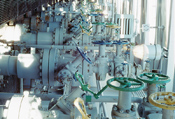
|
|
RCM

RCM stands for Reliability-Centered Maintenance.RCM is an improvement strategy that is used in manufacturing.Its technical definition is that it is "focused on identifying and establishing the operational, maintenance, and capital improvement policies that will manage the risks of equipment failure most effectively." RCM address must address at least the following seven questions:
|
|
- What is the item supposed to do?
- In what ways can it fail to provide the required functions?
- What are the events that cause each failure?
- What happens?
- Why does it matter?
- What systematic task can be performed proactively to prevent, or to diminish to a satisfactory degree, the consequences of the failure?
- What must be done if a suitable preventive task cannot be found?
The basic characteristics of the RCM process are to report risks due to technical failure that may pose a threat to safety, to operations, and to the maintenance budget.As environmental concerns have become more apparent and manufacturing plants have taken a lot of the heat when it comes to being environmentally responsible, modern RCM strategies show threats to the environment a separate classification.In an RCM risk management strategy, the performance of any given operation is classified as one of the following: on-condition maintenance tasks, scheduled restoration or discard maintenance tasks, failure-finding maintenance tasks, and one-time changes to the "system."
In addition to having a risk assessment and reporting system in place, RCM focuses on those items within the manufacturing operation that would cause the most disruption if they were to fail.The goal is to maintain the functions that the operator of the machine needs in order to carry out his assigned task as part of the process.Naturally then it makes sense that as part of the RCM system, workers need to become familiar with the workings of the machines and other physical assets of which operations they are held accountable.It is the worker's responsibility through their familiarization of their work-assigned physical assets, to identify a Failure Mode Effects and Criticality Analysis which outlines the operating context of the machinery.The next thing that needs to be done is to determine the appropriate maintenance tasks to each piece of machinery in operation.Once this process is completed with all of the elements that are a part of the task completion process, they are bundled together into a single RCM package.The effectiveness of these reports also requires maintenance to ensure that adjustments are being made so that pieces of equipment are properly maintained and failures are avoided.
Reliability Centered Maintenance is used largely as a way to avoid costly equipment failure.The RCM approach is a way of providing equipment with a routine maintenance program that I designed to screen for the most common cause of equipment failure so that neither the function of the equipment nor the piece of machinery itself is significantly hindered or damaged.Levels of criticality are assigned to the consequences of failure. Some functions are not critical and are left to "run to failure" while other functions must be preserved at all cost. When the risk of failure to a given system is too high or failure occurs too often, this becomes a signal that change is needed so that the system operation can again be brought to a level that is considered acceptable in the context of the other functions of the system.
Maintenance tasks are selected that address the dominant failure causes. This process directly addresses maintenance preventable failures. Failures caused by unlikely events, non-predictable acts of nature, etc. will usually receive no action provided their risk (combination of severity and frequency) is trivial (or at least tolerable). When the risk of such failures is very high, RCM encourages (and sometimes mandates) the user to consider changing something which will reduce the risk to a tolerable level.
Some organizations find it useful to use predictive maintenance strategies in addition to the traditional preventative measures of RCM.Companies that choose to do this are generally highly controlled and have higher risks to overall productivity were there to be system failures.
Privacy Policy, Terms of Use